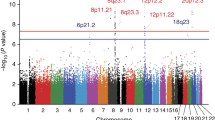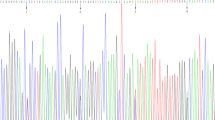Abstract
Ossification of the posterior longitudinal ligament of the spine (OPLL) is a common musculoskeletal disease among people after middle age. The OPLL presents with serious neurological abnormalities due to compression of the spinal cord and nerve roots. The OPLL is caused by genetic and environment factors; however, its etiology and pathogenesis still remain to be elucidated. To determine the susceptibility loci for OPLL, we performed a genome-wide linkage study using 214 affected sib-pairs of Japanese. In stratification analyses for definite cervical OPLL, we found loci with suggestive linkage on 1p21, 2p22–2p24, 7q22, 16q24 and 20p12. Fine mapping using additional markers detected the highest non-parametric linkage score (3.43, P = 0.00027) at D20S894 on chromosome 20p12 in a subgroup that had no complication of diabetes mellitus. Our result would shed a new light on genetic aspects of OPLL.


Similar content being viewed by others
References
Stapleton CJ, Pham MH, Attenello FJ, Hsieh PC (2011) Ossification of the posterior longitudinal ligament: genetics and pathophysiology. Neurosurg Focus 30:E6
Matsunaga S, Sakou T (2012) Ossification of the posterior longitudinal ligament of the cervical spine: etiology and natural history. Spine 37:E309–E314
Saetia K, Cho D, Lee S, Kim DH, Kim SD (2011) Ossification of the posterior longitudinal ligament: a review. Neurosurg Focus 30:E1
Taketomi E, Sakou T, Matsunaga S, Yamaguchi M (1992) Family study of a twin with ossification of the posterior longitudinal ligament in the cervical spine. Spine 17:S55–S56
Matsunaga S, Sakou T (1997) Epidemiology of ossification of the posterior longitudinal ligament. In: Yonenobu K, Sakou T, Ono K (eds) Ossification of the posterior longitudinal ligament. Springer, Tokyo, pp 11–17
Sakou T, Matsunaga S, Koga H (2000) Recent progress in the study of pathogenesis of ossification of the posterior longitudinal ligament. J Orthop Sci 5:310–315
Koga H, Hayashi K, Taketomi E, Matsunaga S, Yashiki S, Fujiyoshi T, Sonoda S, Sakou T (1996) Restriction fragment length polymorphism of genes of the alpha 2(XI) collagen, bone morphogenetic protein-2, alkaline phosphatase, and tumor necrosis factor-alpha among patients with ossification of posterior longitudinal ligament and controls from the Japanese population. Spine 21:469–473
Tanaka T, Ikari K, Furushima K, Okada A, Tanaka H, Furukawa K, Yoshida K, Ikeda T, Ikegawa S, Hunt SC, Takeda J, Toh S, Harata S, Nakajima T, Inoue I (2003) Genomewide linkage and linkage disequilibrium analyses identify COL6A1, on chromosome 21, as the locus for ossification of the posterior longitudinal ligament of the spine. Am J Hum Genet 73:812–822
Nakamura I, Ikegawa S, Okawa A, Okuda S, Koshizuka Y, Kawaguchi H, Nakamura K, Koyama T, Goto S, Toguchida J, Matsushita M, Ochi T, Takaoka K, Nakamura Y (1999) Association of the human NPPS gene with ossification of the posterior longitudinal ligament of the spine (OPLL). Hum Genet 104:492–497
Wang H, Liu D, Yang Z, Tian B, Li J, Meng X, Wang Z, Yang H, Lin X (2008) Association of bone morphogenetic protein-2 gene polymorphisms with susceptibility to ossification of the posterior longitudinal ligament of the spine and its severity in Chinese patients. Eur Spine J 17:956–964
Furushima K, Shimo-Onoda K, Maeda S, Nobukuni T, Ikari K, Koga H, Komiya S, Nakajima T, Harata S, Inoue I (2002) Large-scale screening for candidate genes of ossification of the posterior longitudinal ligament of the spine. J Bone Miner Res 17:128–137
Kamiya M, Harada A, Mizuno M, Iwata H, Yamada Y (2001) Association between a polymorphism of the transforming growth factor-beta1 gene and genetic susceptibility to ossification of the posterior longitudinal ligament in Japanese patients. Spine 26:1264–1266 (discussion 1266–1267)
Horikoshi T, Maeda K, Kawaguchi Y, Chiba K, Mori K, Koshizuka Y, Hirabayashi S, Sugimori K, Matsumoto M, Kawaguchi H, Takahashi M, Inoue H, Kimura T, Matsusue Y, Inoue I, Baba H, Nakamura K, Ikegawa S (2006) A large-scale genetic association study of ossification of the posterior longitudinal ligament of the spine. Hum Genet 119:611–616
Liu Y, Zhao Y, Chen Y, Shi G, Yuan W (2010) RUNX2 polymorphisms associated with OPLL and OLF in the Han population. Clin Orthop Relat Res 468:3333–3341
Matsunaga S, Yamaguchi M, Hayashi K, Sakou T (1999) Genetic analysis of ossification of the posterior longitudinal ligament. Spine 24:937–938
Numasawa T, Koga H, Ueyama K, Maeda S, Sakou T, Harata S, Leppert M, Inoue I (1999) Human retinoic X receptor beta: complete genomic sequence and mutation search for ossification of posterior longitudinal ligament of the spine. J Bone Miner Res 14:500–508
Kobashi G, Ohta K, Washio M, Okamoto K, Sasaki S, Yokoyama T, Miyake Y, Sakamoto N, Hata A, Tamashiro H, Inaba Y, Tanaka H (2008) FokI variant of vitamin D receptor gene and factors related to atherosclerosis associated with ossification of the posterior longitudinal ligament of the spine: a multi-hospital case–control study. Spine 33:E553–E558
Ogata N, Koshizuka Y, Miura T, Iwasaki M, Hosoi T, Shiraki M, Seichi A, Nakamura K, Kawaguchi H (2002) Association of bone metabolism regulatory factor gene polymorphisms with susceptibility to ossification of the posterior longitudinal ligament of the spine and its severity. Spine 27:1765–1771
Kim DH, Jeong YS, Chon J, Yoo SD, Kim HS, Kang SW, Chung JH, Kim KT, Yun DH (2011) Association between interleukin 15 receptor, alpha (IL15RA) polymorphism and Korean patients with ossification of the posterior longitudinal ligament. Cytokine 55:343–346
Chung WS, Nam DH, Jo DJ, Lee JH (2011) Association of toll-like receptor 5 gene polymorphism with susceptibility to ossification of the posterior longitudinal ligament of the spine in Korean population. J Korean Neurosurg Soc 49:8–12
Broman KW, Murray JC, Sheffield VC, White RL, Weber JL (1998) Comprehensive human genetic maps: individual and sex-specific variation in recombination. Am J Hum Genet 63:861–869
Ikari K, Onda H, Furushima K, Maeda S, Harata S, Takeda J (2001) Establishment of an optimized set of 406 microsatellite markers covering the whole genome for the Japanese population. J Hum Genet 46:207–210
Brownstein MJ, Carpten JD, Smith JR (1996) Modulation of non-templated nucleotide addition by Taq DNA polymerase: primer modifications that facilitate genotyping. Biotechniques 20:1004–1006, 1008–1010
Saito M, Saito A, Kamatani N (2002) Web-based detection of genotype errors in pedigree data. J Hum Genet 47:377–379
Kruglyak L, Lander ES (1995) Complete multipoint sib-pair analysis of qualitative and quantitative traits. Am J Hum Genet 57:439–454
Lander E, Kruglyak L (1995) Genetic dissection of complex traits: guidelines for interpreting and reporting linkage results. Nat Genet 11:241–247
Wu JC, Liu L, Chen YC, Huang WC, Chen TJ, Cheng H (2011) Ossification of the posterior longitudinal ligament in the cervical spine: an 11-year comprehensive national epidemiology study. Neurosurg Focus 30:E5
Kobashi G, Washio M, Okamoto K, Sasaki S, Yokoyama T, Miyake Y, Sakamoto N, Ohta K, Inaba Y, Tanaka H (2004) High body mass index after age 20 and diabetes mellitus are independent risk factors for ossification of the posterior longitudinal ligament of the spine in Japanese subjects: a case–control study in multiple hospitals. Spine 29:1006–1010
Shingyouchi Y, Nagahama A, Niida M (1996) Ligamentous ossification of the cervical spine in the late middle-aged Japanese men. Its relation to body mass index and glucose metabolism. Spine 21:2474–2478
Koga H, Sakou T, Taketomi E, Hayashi K, Numasawa T, Harata S, Yone K, Matsunaga S, Otterud B, Inoue I, Leppert M (1998) Genetic mapping of ossification of the posterior longitudinal ligament of the spine. Am J Hum Genet 62:1460–1467
Buxbaum JD, Silverman JM, Smith CJ, Kilifarski M, Reichert J, Hollander E, Lawlor BA, Fitzgerald M, Greenberg DA, Davis KL (2001) Evidence for a susceptibility gene for autism on chromosome 2 and for genetic heterogeneity. Am J Hum Genet 68:1514–1520
Kawaguchi H, Akune T, Ogata N, Seichi A, Takeshita K, Nakamura K (2006) Contribution of metabolic conditions to ossification of the posterior longitudinal ligament of the spine. In: Yonenobu K, Nakamura K, Toyama Y (eds) OPLL (ossification of the posterior longitudinal ligament), 2nd edn. Springer, Tokyo, pp 71–75
Takeuchi Y, Matsumoto T, Takuwa Y, Hoshino Y, Kurokawa T, Shibuya N, Ogata E (1989) High incidence of obesity and elevated serum immunoreactive insulin level in patients with paravertebral metabolism ligamentous ossification; a relationship to the development of ectopic ossification. J Bone Miner Metab 7:17–21
Nobta M, Tsukazaki T, Shibata Y, Xin C, Moriishi T, Sakano S, Shindo H, Yamaguchi A (2005) Critical regulation of bone morphogenetic protein-induced osteoblastic differentiation by Delta1/Jagged1-activated Notch1 signaling. J Biol Chem 280:15842–15848
Kung AW, Xiao SM, Cherny S, Li GH, Gao Y et al (2010) Association of JAG1 with bone mineral density and osteoporotic fractures: a genome-wide association study and follow-up replication studies. Am J Hum Genet 86:229–239
Kawaguchi H, Kurokawa T, Hoshino Y, Kawahara H, Ogata E, Matsumoto T (1992) Immunohistochemical demonstration of bone morphogenetic protein-2 and transforming growth factor-beta in the ossification of the posterior longitudinal ligament of the cervical spine. Spine 17:S33–S36
Tanaka H, Nagai E, Murata H, Tsubone T, Shirakura Y, Sugiyama T, Taguchi T, Kawai S (2001) Involvement of bone morphogenic protein-2 (BMP-2) in the pathological ossification process of the spinal ligament. Rheumatology 40:1163–1168
Evans DM, Cardon LR (2004) Guidelines for genotyping in genomewide linkage studies: single-nucleotide-polymorphism maps versus microsatellite maps. Am J Hum Genet 75:687–692
Onouchi Y, Gunji T, Burns JC, Shimizu C, Newburger JW et al (2008) ITPKC functional polymorphism associated with Kawasaki disease susceptibility and formation of coronary artery aneurysms. Nat Genet 40:35–42
Onouchi Y, Tamari M, Takahashi A, Tsunoda T, Yashiro M, Nakamura Y, Yanagawa H, Wakui K, Fukushima Y, Kawasaki T, Hata A (2007) A genomewide linkage analysis of Kawasaki disease: evidence for linkage to chromosome 12. J Hum Genet 52:179–190
Acknowledgments
We thank OPLL patients and their families who participated in this study and the Japan OPLL Network, including Ishikawa-prefecture OPLL Tomo-no-kai. We also thank members of the Genetic Study Group of Investigation Committee on Ossification of the Spinal Ligaments. The work reported in this article was supported by a Grant for Intractable Diseases from the Public Health Bureau, the Ministry of Health and Welfare of Japan (Investigation Committee on Ossification of the Spinal Ligaments).
Conflict of interest
All authors state that they have no conflicts of interest.
Author information
Authors and Affiliations
Consortia
Corresponding author
Additional information
T. Karasugi and M. Nakajima contributed equally to this work.
About this article
Cite this article
Karasugi, T., Nakajima, M., Ikari, K. et al. A genome-wide sib-pair linkage analysis of ossification of the posterior longitudinal ligament of the spine. J Bone Miner Metab 31, 136–143 (2013). https://doi.org/10.1007/s00774-012-0404-y
Received:
Accepted:
Published:
Issue Date:
DOI: https://doi.org/10.1007/s00774-012-0404-y




